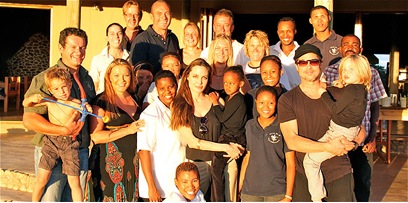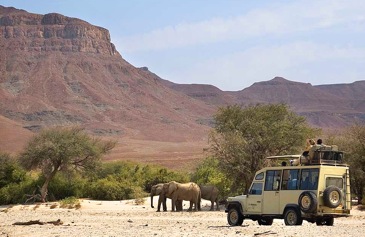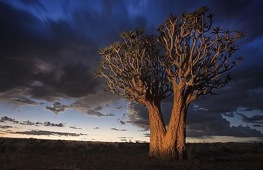
"From a certain point onward there is no longer any turning back. That is the point that must be reached" ~ Kafka
With the news last month that Brad Pitt and Angelina Jolie pledged $2 million to help further the work of the N/a'an ku se Sanctuary in Namibia, the birthplace of their daughter Shiloh, after spending Christmas at the wildlife lodge, it seems time to check out what has become the Brangelina back yard.
So it is I set out for Namibia and its Fish River Canyon, often called the Grand Canyon of Africa, though the comparison is a bit disingenuous since both the Blue Nile and the Tekeze in Ethiopia run through gorges deeper. My excuse is a scout, to explore a possible river tour down the river, which runs only a few weeks a year, in the Namibian summer during the short rainy season. As far as I can tell nobody has ever taken a raft down this defile 99 miles long and 17 miles wide, and I have spent a career tracking recherché rivers to run. And there are warnings, which always make the conceit more tempting. It will be too hot (over 120 degrees); it is the rainy season and there are killer flash floods. An email from one South African outfitter warns: "During the summer months and the rains it is lethal to get trapped in the canyon. The river can (and often does) go totally berserk and there is no way out of the canyon for more than 60 miles. I've been crazy (so everyone tells me...) for more years than I care to remember and it scares the bejesus outta me just to think about it!" A 32-year-old Frenchman, Francois Roger, tried to hike the canyon a year ago January, fell and broke his leg and fried to death in the heat.
The caveats they set my blood racing. There is something vitally appealing about braving an interdict. But, the prospect of trekking through a desert canyon, of plucking the strings of simplicity, I am finding to be the most alluring aspect of the call.
I unwrap a layer, leaving an overstuffed closet behind. Still, I pack too much, a huge duffle crammed with triple and quadruple of everything: shirts, shorts, footwear, rainwear, and all sorts of otiose extras I know I will never use.
In the jigsaw puzzle that is Africa, Namibia is the piece that got left behind. The barren state, larger than Texas, lies north of South Africa's western border and most of its eastern edge abuts Botswana. Like Papua New Guinea, Namibia was a German colony until the end of the First World War when the League of Nations entrusted South West Africa, as it was then known, to South Africa as a mandated territory. The country gained independence in 1990, yet it remains one of the least-explored domains on the continent.
With ten friends I find my way to Windhoek, the mile-high period piece of a capital awash in bougainvillea, sprawled in the shadow of the Eros Mountains. At the shiny Windhoek Country Club & Casino, our palace for a single night in the city, the cobwebs of the Kaiser's colonial presence have long blown away, and ample glasses of single-malt blow away ours.
In the morning we wheel south into the vast, rocky ocean that is the Namibian desert, an endless retreat of buttes and ravines, ridges and terraced escarpments, the compacted age lines of the earth as deep and hard and revealing as the dark weather-carved face of an aged German miner. We trundle south beyond the Tropic of Capricorn, south past running ostriches, baboons and goshawks, down past flat-topped acacias and euphorbias with stems vivid as trails of fireworks. The bare, rocky bones of the earth show through the road-edge soil. In the distance sharp crests of rock rise above the surface like dorsal fins of giant fish. For hours the road cleaves an arrow path across raw territory, among the emptiest on earth. The land feels drained of life - cracked and brittle, like a piece of old leather. A landscape, this is, cruelly lacking in sentiment.
Our host is Louis Fourie, a former South African wine farmer of corybantic energy and sun-pinched eyes who had a dream when he was 14 to own land where he couldn't see the borders. Prodigal with his plans, he purchased 36,000 acres, including the upper Fish River Canyon, for a song some nine years before. He has fashioned a modest lodge which will serve as our base camp. The plan is to spend a few days hiking the upper canyon on Louie's land, then do a trek into the main canyon in the national park, and then a couple fly-overs for aerial recces. Our timing seems spot on, as until a few days before all the canyon had seen were what Louis calls "bankruptcy clouds," the high wispy, rainless streaks that will cause a waiting farmer to go under. But by the time we board the plane stateside it has started to rain, the first water in the canyon in 10 months. "The river floods this time of year, "Louis warns. "It can get up to 250,000 cubic feet per second." This seems a bit of a stretch, as that would be more than ten times the flow of the Colorado through the Grand Canyon, which drains the western slopes of the snow-coated Rockies. There is no snow in Namibia. He also says we can drink the water untreated, but it seems he is traducing the canyon, and none of us take his word on that.
Our tires crackle into Louie's hardscrabble oasis mid-afternoon, a former farmhouse his wife Riette has decorated with her own artwork, heirlooms and cozy appointments, a green salad in a brown bowl of eroded cliffs and tors. We start to pack for our first foray into the canyon the next day. Our team includes Outside Magazine editor-at-large Tim Cahill; Pasquale Scaturro, leader of the blind climb up Mount Everest in 2001; Dr. Seth Berkley, President of The International AIDS Vaccine Initiative; Peggy Dulany, chair of the poverty-fighting institute Synergos; Lisa Conte, CEO of Shaman Pharmaceuticals, and several other rogues and scalawags. Louis's garrulous mother, Gerty, has flown up from South Africa to be our cook, and grills up tasty servings of klipspringer and gemsbok, which we wash down with Windhoek lagers, supposedly brewed to German purity rules. As the sun fires a gorgeous sunset against an oxide-red cliff we take to swimming in a pond fresh from the rains. Then we sit on the porch talking and sipping 15-year old Glendronach whisky. At one point a giant scorpion, looking like the creature in Alien, scuttles across the floorboards, and Riette jumps on the table and screeches. It is a wind scorpion. "Lots more of those in the canyon, "Louie speaks gently in a tone of obscure reproof.
That night the gibbous moon pours into the bowers a flood of violent light. A hard time I have sleeping.

It is Sunday morning, and the sun shoots up and decants a vast, hard light. We decide to do a shake-down hike, an 11-mile tramp in which we will drop into an unnamed fissure, climb out the other side, then descend into the Lion River Gorge, which disembogues into the Fish River Canyon. We will then hike downstream several miles to first night camp, which is accessible with a four-wheel drive vehicle, and Louis will arrange to have our tents and bags trucked around, along with iced drinks, steaks, tiki lamps, plastic chairs, and a box of Cuban cigars. So, all we will need for the day will be water and a day pack. Another layer shed. Nonetheless, I can't let go, and stuff my Osprey daypack with extra shirts, shorts, socks and shoes, snacks, rainwear, my knife, matches, three Nalgene water bottles, Iodine tablets, sunscreen, bandanas, a medical kit, compass, whistle, two flashlights, extra batteries, pens, a journal, and a book on desert survival.
"You taking the sat phone?" I call to Pasquale as we are loading into the trucks, referring to the Inmarsat mini-M satellite telephone Pasquale brought for emergencies. "Nah....it's just a day hike. I'll have it shipped around to camp."
"Makes sense," I agree. It's heavy, and this is just the warm-up, a chance to test our hiking boots; to acclimatize to the heat, and set our paces for the next several days. We won't even need our 1:50,000 topo maps or GPSs.
Louis decides to manage the moving of our gear to camp, so Riette volunteers to be our guide, though she had never done the hike. Nonetheless, confidence she instills just with her attire...while we are decked out in candy-colored REI wear and brand new Leki poles, she wears a tennis suit and sneakers, as though this is a stroll to the courts. And she bobs down the trail, not so much hiking as sailing. Here we go, Bratpackers in Paradise.
The hike begins simply, down a mountain zebra path into a gash in the skin of the desert. Mud crisped into a lattice of curved flakes crunches under my feet. The landscape is dotted with quiver trees, weird aloes that look like hangovers from a Dr. Seuss book.
The Bushmen used their hollow branches to hold arrows. I stay with Riette in the front, who describes some of the plants and rocks as we trip into a canyon blindingly bright and untarnished by time. We see klipspringers, the tiny-horned wraiths that make silent, serpentine leaps along the blistered cliffs. We see heart-shaped leopard paw prints, dark beads round as pearls, the scat of a kudu, and the dried carcass of a rock dassie. We hie past looney bushes, succulents and desert annuals, blooming after the rains. A pair of green parrots, local love birds, flit across a frowning canyon wall. Then we ascend the other side, and gain the shadows of a wall where we stoop on pieces of shale and gulp water and chew springbok jerky, which though tasty sits like rubber in my belly. Already we are feeling the heat, and we linger longer than we should. Across from us a kestrel rises from a look-out rock and wheels with motionless wings ever higher and higher on the thermals.
We climb out of the small canyon, work our way across a wind-scored plateau dotted with daisies, and a more delicate, pale yellow flower crouching low to the ground. There are golden blazes of another flower, glaring in the sun like an exotic starfish. Delicate pink blooms nod from wispy stems and blue wildflowers stud the ground like discarded sapphires. If not so hot, this would be a lovely place.
Then we began our plunge down a Precambrian staircase, a flight of a billion years or so, down through layers of sedimentary, metamorphic and igneous rock to the Lion River. In the mists of geological time, a sea bed was lifted miles above the level of the ocean and weathered into ranges of table mountains. Then some 500 million years ago, a fault opened up. Widened by glaciation and altered by more faults and wind erosion, canyons within canyons were formed until 50 million years ago a river began to flow.
The canyon is steep, narrow, and the rocks loose. Some stones are sharp, others slant off into slabs, still others have been scalloped by flood-borne pebbles into smooth potholes slippery as ice. "What do we do if it flashfloods?" Lisa asks. "We'll have time," I offer, remembering flash floods down tributaries of the Grand Canyon when I was a river guide many years ago. "There is warning...it sounds like a freight train coming. Then we head for high ground," and we all descry the steep walls to map a route upward.
The experience of our group ranges wide, from Everest vet to outdoor tyro. Shannon Rutherford, an elegant glass of fashion who lives in Las Vegas has never been camping, never gone on a multi-day hike. But when several times offered the chance to back out of the adventure, she insisted she wanted to give it a go. And a trooper she is. But by mid-day she isn't feeling well, and stops to vomit. Jim Laurel, the photographer, turns his ankle on some wobbly rocks, and is limping a bit. Russ Sach is developing a rash. When we all pull off our boots to jump into a limestone pool to cool off about half the feet are angry with blisters.
After the dip I feel energized, and find myself in the front of the pack with Riette and Peggy and a couple others. We cross a layer of red-brown quartzite, and intersect with the Lion River, and began to make our way down towards the Fish, when suddenly we hear the bright blade of Russ's voice as he races towards us. "Hold up! Hold up! Seth broke his ankle!"Sphere: Related Content
![Validate my Atom 1.0 feed [Valid Atom 1.0]](valid-atom.png)























































